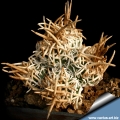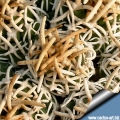Accepted Scientific Name: Pediocactus peeblesianus f. menzelii Hájek
Kaktusy (Brno) 36(3): 73. 2000

Navajoa peeblesiana f. menzelii (Pediocactus peeblesianus f. menzelii) Photo by: Valentino Vallicelli
RP 116 South-West of Grand Canyon, Hualapai Hiltop Area, Coconino County, Arizona, USA
Origin and Habitat: USA (northern Arizona), 1500-1650 m elevation.
Habitat: Grows in well drained gravelly soils of alkaline desert scrub and desert grasslands; 1200-1650 m; The plant retracts in the soil during dry weather. Although the area this cactus is coming from is very dry, it has a rainy season in winter and one in late summer, as is typical in Arizona.
Synonyms:
See all synonyms of Pediocactus peeblesianus
Common Names include:
ENGLISH: Menzel´s Cactus, Cataract Creek Cactus, Navajo Cactus, Peeble's Cactus, Peeble's Hedghog Cactus
Description: It is a small, generally solitary (or with a very few branches) cactus.
Stem: Stems grey-green, obovoid, or depressed-globose up to 2,5(6) cm tall and averaging 1.5(5) cm in diameter.
Areoles: Areoles circular, woolly.
Spines: Usually radial and central (rarely all radial) soft corky or spongy, harder at tips, white to pale grey and sometimes 0-1 intermediate spines per areole
Radial spines: Usually 4 (o more) that form a twisted cross, 3-7 long.
Intermediate spines: Curved upward, 8-21 long,
Central spines: Usually 1 per areole, there are no central spines in young specimens, a stouter spongy and flexible central spine will appears in older plants this spine is straight to strongly curved 5-18 × 1 mm.
Flowers:: Yellow to yellow green up to 2.5 cm in diameter, often larger than and hiding the smaller plant body below. Scales and outer tepals minutely toothed or denticulate or entire and undulate; outer tepals with brown-purple midstripes, oblanceolate 1-1.4 × 1.5-2.5 cm;, 5-13 × 2-4.5 mm; inner tepals cream, yellow, or yellowish green, lanceolate, 6-12(-15) mm. They are not self-fertile.
Flowering season: Spring.
Fruit: Dry, turbinate, 6-11 × 5-8 mm turning tan at maturity, dehiscing by both a dorsal slit and by a ring around the circumscissile apex.
Seeds: Dark brown to black, 3 × 2 mm, papillate and rugose.
Subspecies, varieties, forms and cultivars of plants belonging to the Pediocactus peeblesianus group
 Pediocactus peeblesianus (Croizat) L.D.Benson: has white to pale grey corky/spongy, and flexible not obscuring the stem.Central spine: (3-)4 (rarely 6), of oftene flattened into a Maltese cross arrangement. Radial spines: 3-7 per areole. Distribution: Navajo County, Arizona.
Pediocactus peeblesianus (Croizat) L.D.Benson: has white to pale grey corky/spongy, and flexible not obscuring the stem.Central spine: (3-)4 (rarely 6), of oftene flattened into a Maltese cross arrangement. Radial spines: 3-7 per areole. Distribution: Navajo County, Arizona. Pediocactus peeblesianus subs. fickeisenii (Hochstätter) Lüthy: Has longer and thinner corky/spongy, white to pale grey spines. Central spine: 1-4 stout, wormlike, curved, ascending 0,5-2,5 cm long. Radial spines: 3 to 7. Distribution: Grand Canyon Area, Arizona.
Pediocactus peeblesianus subs. fickeisenii (Hochstätter) Lüthy: Has longer and thinner corky/spongy, white to pale grey spines. Central spine: 1-4 stout, wormlike, curved, ascending 0,5-2,5 cm long. Radial spines: 3 to 7. Distribution: Grand Canyon Area, Arizona. Pediocactus peeblesianus subs. fickeisenii f. cristatus hort.: crested form.
Pediocactus peeblesianus subs. fickeisenii f. cristatus hort.: crested form. Pediocactus peeblesianus f. maius (Hochstätter) Hájek: is a controversial forms of Pediocactus peeblesianus that should actually be regarded as non-existent (nomen nudum) because is based on a juvenile form of another taxon (Echinocereus fendleri).
Pediocactus peeblesianus f. maius (Hochstätter) Hájek: is a controversial forms of Pediocactus peeblesianus that should actually be regarded as non-existent (nomen nudum) because is based on a juvenile form of another taxon (Echinocereus fendleri). Pediocactus peeblesianus f. menzelii Hájek: has radial and central (rarely all radial) soft corky or spongy, "fatter" than in the ptype, white to pale grey and sometimes 0-1 intermediate spines per areole. Distribution: Coconino County, Arizona
Pediocactus peeblesianus f. menzelii Hájek: has radial and central (rarely all radial) soft corky or spongy, "fatter" than in the ptype, white to pale grey and sometimes 0-1 intermediate spines per areole. Distribution: Coconino County, Arizona
Bibliography: Major references and further lectures
1) Edward F. Anderson “The Cactus Family” Timber Press, 2001
2) Curt Backeberg “Cactus Lexicon” Sterling Publishing Company, Incorporated, 1978
3) David Hunt, Nigel Taylor “The New Cactus Lexicon” DH Books, 2006 ISBN 0953813444, 9780953813445
4) James Cullen, Sabina G. Knees, H. Suzanne Cubey “The European Garden Flora Flowering Plants: A Manual for the Identification of Plants Cultivated in Europe, Both Out-of-Doors and Under Glass” Cambridge University Press, 11/Aug./2011
 Navajoa peeblesiana f. menzelii (Pediocactus peeblesianus f. menzelii) Photo by: Valentino Vallicelli
Navajoa peeblesiana f. menzelii (Pediocactus peeblesianus f. menzelii) Photo by: Valentino Vallicelli Navajoa peeblesiana f. menzelii (Pediocactus peeblesianus f. menzelii) Photo by: Valentino Vallicelli
Navajoa peeblesiana f. menzelii (Pediocactus peeblesianus f. menzelii) Photo by: Valentino Vallicelli Pediocactus peeblesianus forma menzelii (Pediocactus peeblesianus f. menzelii) Photo by: Valentino Vallicelli
Pediocactus peeblesianus forma menzelii (Pediocactus peeblesianus f. menzelii) Photo by: Valentino Vallicelli Navajoa peeblesiana f. menzelii (Pediocactus peeblesianus f. menzelii) Photo by: Cactus Art
Navajoa peeblesiana f. menzelii (Pediocactus peeblesianus f. menzelii) Photo by: Cactus Art Navajoa peeblesiana f. menzelii (Pediocactus peeblesianus f. menzelii) Photo by: Valentino Vallicelli
Navajoa peeblesiana f. menzelii (Pediocactus peeblesianus f. menzelii) Photo by: Valentino Vallicelli Navajoa peeblesiana f. menzelii (Pediocactus peeblesianus f. menzelii) Photo by: Valentino Vallicelli
Navajoa peeblesiana f. menzelii (Pediocactus peeblesianus f. menzelii) Photo by: Valentino Vallicelli Navajoa peeblesiana f. menzelii (Pediocactus peeblesianus f. menzelii) Photo by: Prof. Ilham Alakbarov
Navajoa peeblesiana f. menzelii (Pediocactus peeblesianus f. menzelii) Photo by: Prof. Ilham Alakbarov Navajoa peeblesiana f. menzelii (Pediocactus peeblesianus f. menzelii) Photo by: Cactus Art
Navajoa peeblesiana f. menzelii (Pediocactus peeblesianus f. menzelii) Photo by: Cactus ArtCultivation and Propagation: Pediocactus peeblesianusSN|11412]]SN|11412]] f. menzelii is a most beautiful cactus but rarely seen in cultivation. It is quite difficult to grow on its own roots. Very easily rot! It’s thought that’s better to watch this species in photo or in the natural habitat rather than to try to cultivate it. For this reasons the plant is often grafted on a frost hardy stock.
Soil: Use mineral well-permeable substratum with very little or no organic matter (peat, humus).
It needs perfect drainage to flourish.
Repotting: Repotting every 2-3 years. As it is especially prone to rot under-pot in a smaller container filled with very porous compost. Use pot with good drainage.
Exposition: This plant need full sun and above all a very good ventilation, especially in winter. Tends to bronze in strong light, which encourages flowering and heavy spine production.
Watering:It needs regular water in late winter, early spring (the short main growing season), and also in Autumn and keep totally dry during winter. In the rest period no high atmospheric humidity!!Care must be taken with watering as they tends to become swollen and untidy in growth habit if given too much water and shade.
Fertilization: During the growing season enrich the soil using a fertilizer rich in potassium and phosphorous, but poor in nitrogen, because this chemical element doesn’t help the development of succulent plants, making them too soft and full of water.
Hardines: It can tolerate temperature below zero (-15° C or less). Mature individuals - if the growing conditions are not optimal, easily rot and die.
Pests & diseases: It may be attractive to a variety of insects to watch for:
- Red spiders: Sensitive to red spider mite. Overhead watering is helpful in controlling mites.
- Mealy bugs: Occasionally mealy bugs they develop aerial into the new growth among the wool with disfiguring results, but the worst types develop underground on the roots and are invisible except by their effects.
- Rot: Rot it is the major threat . If the plants are not watered and “aired” correctly, fungicides won't help all that much.
Remarks: Displaying your cacti on shelves has the added benefit of keeping them off the ground and away from potential rodent or snail damage.
Propagation: Seed or grafting. Temperature for optimum germination: night minimum approx 17 day maximum to near 40 C at any time of year with proper temperatures and day-length (ca.13-14 hours); it is possible to extend day-length with artificial lights. Anyway the seeds germinate slowly with difficulty and a low rate of success (But germiation is comparatively easy if compared with other Pediocactus and Sclerocactus species and often new seedling cluster spontaneously around the plant every year), scarification and stratification help, alternate freeze and thaw both wet and dry, but don’t keep wet, alternate wet and dry with changing temperature. Germination can take several years so keep pot and try again next year. Seedlings do not do well either, and some die each year, for this reason plants are commonly grafted on hardy stocks like Opuntia humifusaSN|11629]]SN|11629]] in this case they are easy to grow and no special skill is required. This species is better and easier if grafted.
Your Photos

by Cactus Art

by Cactus Art

by Cactus Art

by Cactus Art

by Cactus Art























